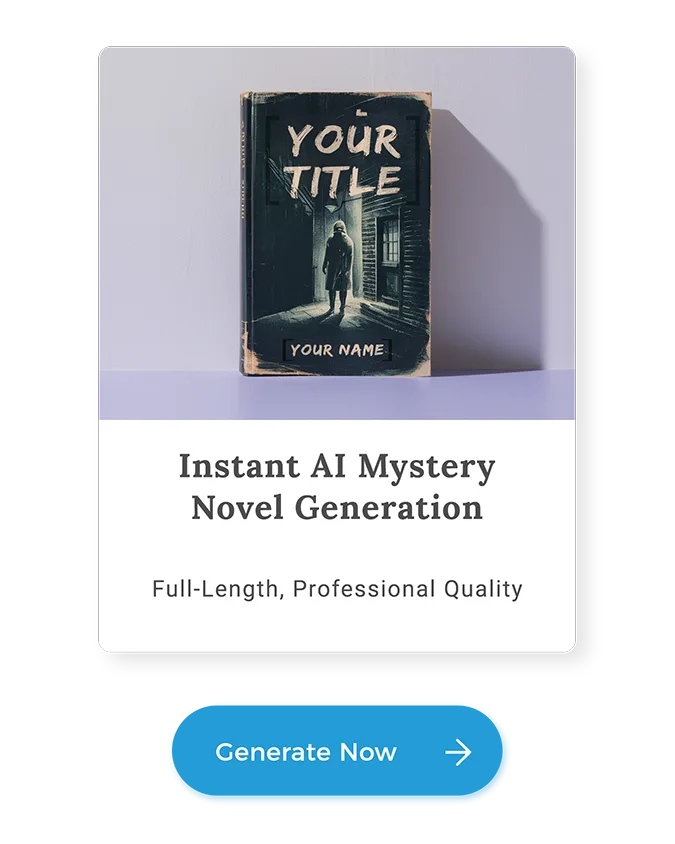Mystery is one of the most intriguing genres in literature. While many people try their hand at writing this genre, few know how to do it successfully. To write a great mystery novel is to assemble a puzzle where each piece hints at a part of the truth but keeps the whole picture out of reach until the final page.
It involves drawing readers into a world filled with secrets, where characters have hidden agendas, and each new clue provides either a brick wall or a breakthrough. The appeal of mystery novels lies in getting readers to join in on solving the riddle.
Good mystery writing requires more than a clever premise, it demands a mastery of tension, pacing, and character development. This guide will explore how to weave all these elements together.
So pick up your notebooks and sharpen your quills as we unmask the secret of how to write a mystery novel.

What is a Mystery Novel?
Mystery is a genre of literature that involves solving a crime or puzzle. Many of these books invite readers to step into the shoes of a detective or amateur sleuth. They piece together clues and uncover secrets along the way. But the genre stretches far beyond traditional detective stories.
It encompasses a variety of narratives, with a crime or investigation at its center. Thrillers ramp up the tension with high stakes, dangerous criminals, and heart-pounding action. Domestic or cozy mysteries take an intimate approach. These stories often take place in small communities or families, where ordinary situations expose shocking secrets.
For fans of the unknown, supernatural, or paranormal mysteries blend an eerie atmosphere with unexplainable phenomena. They force readers to question what’s real and what lies beyond. In heists and capers, the focus shifts to the planning and execution of complex crimes. The excitement lies in the heist itself and the cat-and-mouse game that follows.
The beauty of a good mystery, whatever the subgenre, is its ability to weave complex puzzles that challenge both the characters and the readers. It keeps everyone on their toes until the very end.

Five Essential Elements of a Mystery Novel
Mystery novels thrive on suspense, intrigue, and the challenge of uncovering hidden truths. A strong plot, compelling characters, and a great setting all work together to create an immersive experience. Let’s break down the essential elements that bring a great whodunit to life.
Plot
At the heart of every mystery novel is a well-crafted plot. It serves as the backbone of the story, guiding readers through a sequence of events.
A successful mystery plot introduces a problem and keeps the reader invested in finding the solution. Every twist, turn, and revelation must feel like an essential piece of the puzzle that builds toward the conclusion.
A strong mystery plot should have a clear beginning, middle, and end. While complexity adds depth, the story should remain clear and well-structured.
Characters
A good mystery isn’t just about the puzzle—it’s about the people caught in it. Strong, well-developed characters bring the story to life. A great mystery novel keeps you guessing, and that only works if every character feels like a real person with something to hide. Character development is key and your readers should see growth and shifting dynamics as the mystery unfolds.
The protagonist, who could be a seasoned detective, amateur police officer, or innocent bystander thrown into chaos, should be compelling enough to carry the narrative. They’ll need more than intelligence and determination–they should have a personal stake in the case.
Meanwhile, suspects, victims, and side characters must be just as layered, each with their secrets, personalities, and possible motives. Even minor characters can play a role in deepening the suspense.
Need help creating complex characters? Squibler’s AI character generator can help you build multidimensional characters with detailed backstories and unique personalities. From cunning antagonists to a cast of suspects, the tool can help you shape them into fully realized characters.

Setting
A gripping mystery thrives on atmosphere, and the setting plays a crucial role in creating the right mood. Your novel can unfold on a fog-drenched city street, a quiet countryside village hiding dark secrets, or a grand estate where every hallway whispers of deception. The environment shapes the tone of the story.
The setting should also serve the plot. A locked-room mystery in a sprawling mansion creates a different kind of tension than one set in a bustling metropolis. The location can present obstacles for the protagonist, provide clues, or even act as a silent witness to the crime. Consider how time of day, weather, and historical context can add layers of intrigue to your story.
Just as characters evolve throughout the story, the setting should also shift. As the mystery unravels, once-familiar places may take on an eerie or dangerous quality. A charming bookstore might transform into a place of hidden dangers. This evolution mirrors the reader’s journey—what seemed ordinary at first glance gains deeper significance as secrets come to light.
Mystery
At the heart of every great mystery novel lies the central puzzle—the question that drives the story forward and keeps readers engaged. A well-crafted mystery balances unpredictability with logic. Every clue should serve a purpose, every red herring should be intentional, and every revelation should feel earned. Mystery readers love the challenge of solving the mystery, but they don’t want to feel cheated. The best mysteries lay all the pieces out in front of the audience, yet still manage to surprise them.
Equally important is the motive behind the mystery. A crime without a strong reason can feel hollow, no matter how well-plotted the twists may be. The best mysteries don’t just answer who did it—they explore why.
Conflict
Conflict is the driving force that propels the plot and forces characters to confront their darkest fears and deepest desires. It doesn’t exist only between the protagonist and the antagonist; it runs through every aspect of the story.
Internal struggles, interpersonal tensions, external threats, conflict is what keeps the reader hooked, pushing the characters to their limits and forcing them to evolve. Without conflict, there is no mystery, no stakes, and ultimately, no story.
If you’re looking to refine your story’s conflict or if you need help creating it, Squibler’s AI Smart Writer can help. With just a few prompts, you can bring your plot’s most intense moments to life.
How to Write a Mystery Novel
Writing a mystery novel requires a keen eye for detail, a solid understanding of human behavior, and a knack for misdirection. Here’s how to write a compelling mystery from start to finish.
Step 1: Chart the Course of Your Mystery
Carefully interwoven clues, suspects, and twists form the foundation of mystery novels. While it may seem tempting to dive right into the writing, taking the time to construct a well-thought-out plot will make all the difference.
Here are a few tips to help:
Start With a Strong Premise
Before you dive into the details, have a clear idea of your central mystery—whether it’s a crime, disappearance, or secret. Think about the “what” and “why” of your story—what happened, and what’s at stake? This will provide a solid base for the plot and ensure that all events tie back to the central question. A strong premise also allows you to create a natural progression in the investigation, setting the stage for all subsequent events.
Create a Roadmap
Once you’ve established your premise, map out the major plot points to guide your story. Start with the inciting incident—the moment that sets everything in motion—and follow it through the key turning points, culminating in the resolution.
Consider how each plot twist or clue will impact the trajectory of the story, and remember to introduce the main clues early so readers can begin piecing things together.
Here’s an example of the plot for Gilliam Flynn’s Gone Girl.

Gone Girl by Gillian Flynn follows the story of Nick and Amy Dunne, a married couple whose relationship unravels after Amy goes missing on their fifth wedding anniversary. As the investigation unfolds, Nick becomes the prime suspect, and his behavior raises suspicions.
Here’s the same plot in the form of Freytag’s Pyramid:
Need help with your mystery plot? Squibler’s Plot Generator can help inspire you.
Allow for Flexibility
A good plot outline is a guide, not a rigid script. As you explore your characters and the world they inhabit, new ideas will emerge. Perhaps a subplot will take on a life of its own, or a new twist will make the ending even more satisfying. Be open to these changes, but ensure they still align with the central mystery and the clues you’ve already planted.
Step 2: Describe The Crime In Detail
At the heart of any great mystery is the crime or event, and the details surrounding it can make or break the story. From the moment the crime occurs, you must know exactly what happened, who was involved, and why. Write these details down before you begin your novel to avoid gaps later on.
Here are some tips to help:
Start with the Crime then Work Backwards
Every mystery begins with an event—a crime, a disappearance, a secret unearthed. Outline every aspect of this incident in detail. Who took part in the crime? What were their motives? How did the act occur, and what evidence remains? Once you know exactly what happened, work backward to plant clues, alibis, and red herrings that will mislead both the protagonist and the reader.
Introduce the Crime Early
Mystery readers expect to dive into the story quickly. Within the first few pages, establish the crime or mysterious event. This doesn’t mean revealing all the details immediately—but the inciting incident should be clear enough to set the investigation in motion.
Ensure Every Detail Fits
The key to a satisfying mystery is airtight logic. If a character appears in two different locations within minutes, does that timeline make sense? If a suspect lies about their whereabouts, does the timeline hold up? Keeping track of every small detail—down to the weather on the night of the crime—ensures your mystery remains believable.
Crafting a compelling mystery requires careful plotting, well-placed clues, and engaging twists. If you need help structuring your story, an AI novel generator will assist in outlining key plot points.
Step 3: Create Convincing Characters
Mysteries aren’t just about the crime—it’s about the people caught in its web, from the victim to the sleuth. The complexity of their relationships and hidden motives should create a web of tension, making it difficult to trust anyone. Take a look at the following murder mystery novel’s characters.

Know Your Victim
Many stories begin with the victim, and their background helps to shape the investigation. Did people love or hate them? Did they have enemies or shocking secrets? A well-developed victim ensures the crime or mysterious event has emotional weight.
Know Your Culprit
Your culprit should have a clear, compelling reason for their crime. Maybe it was out of desperation, revenge, or even a carefully planned scheme. The stronger their motive, the more satisfying the resolution will be.
Remember Your Suspects
A great mystery keeps readers guessing with a diverse cast of suspects, each with a reason to seem guilty. Some will mislead, some will lie, and some will have secrets unrelated to the crime. Balancing red herrings with genuine clues ensures your plot stays unpredictable.
Step 4: Explore Locales
The locales where your story takes place can deepen the intrigue and shape the atmosphere. Each location should serve the story by adding layers of complexity.
Make Your Settings Atmosphere-Driven
The atmosphere of your locales can heighten the tension in your mystery. Use descriptions of the surroundings to reflect the mood of the scene. A foggy graveyard might symbolize mystery and death, while a claustrophobic office could increase feelings of paranoia. Let the environment mirror the emotions your characters are experiencing,
Use Locales to Reflect Character Psyche
A character’s environment can offer subtle insights into their personality, motives, and emotional state. A detective’s cluttered office might suggest their chaotic thought process, while a victim’s pristine home could indicate they were trying to hide something. Let the locations reveal character traits without overtly stating them.
Create a Sense of Place with Local Details
To make your locales feel real, include small, local details that ground the reader in the setting. Whether it’s a distinctive accent, a local café that everyone frequents, or a weather pattern, these details will enrich your world-building and make each location feel authentic.
Step 5: Let The Reader Play Detective
While many mystery novels aim to reveal the truth, the real intrigue lies in the journey of uncovering it. Readers love the thrill of solving a puzzle, and the best mysteries invite them to participate in the investigation.
Here’s how you can accomplish this.
Scatter Clues Throughout
Don’t dump all the important clues at once—spread them throughout the story. While most should be at the beginning, you can sprinkle some throughout your novel. A well-placed clue early on that seems insignificant at first but becomes crucial later will reward observant readers and keep them engaged. Some clues should be subtle, hidden in descriptions or dialogue, while others can be more direct.
Use Red Herrings to Misdirect
To keep readers guessing, introduce false leads and misleading information. Maybe a suspect has a strong motive but an airtight alibi, or an innocent character behaves suspiciously for unrelated reasons. These tricks add complexity and prevent the mystery from feeling too predictable.
Build Suspense with Uncertainty
Keep readers on edge by creating moments of doubt. Just when they think they’ve solved the puzzle, introduce a new piece of information that contradicts their theory. This push and pull of certainty and doubt will keep them hooked until the very last page.
Step 6: Keep up the Pace
A well-paced mystery balances fast-paced moments—like an intense chase or shocking discovery—with slower, tension-filled scenes that allow readers to absorb the clues. Keeping this balance ensures that the story remains engaging from start to finish.
You can achieve good pacing. Here are some ways to do this.
Break Up Exposition with Action
Long stretches of dialogue or exposition can slow the story down, so mix them with movement. Instead of having the detective discuss theories in an office, let them piece things together while chasing a lead, examining a crime scene, or confronting a suspect.
Shorten Sentences to Build Tension
The way you structure your writing can impact the pace of your story. During high-stakes moments, use shorter, punchier sentences to create urgency. In quieter, more reflective moments, longer descriptions can help build atmosphere and suspense.
End Chapters with Cliffhangers
Keep readers flipping pages by ending chapters with questions, discoveries, or unexpected twists. Did the protagonist find a piece of evidence that contradicts everything? Did a suspect go missing? A well-placed cliffhanger ensures that the audience is always eager to find out what happens next.
Step 7: Give a Memorable Ending to your Mystery
A great mystery is only as strong as its ending. After building suspense, dropping clues, and weaving red herrings throughout the story, the final reveal needs to be both satisfying and impactful. By this point, readers should have a solid grasp of the crime—who committed it, how, and why—but the way you choose to unveil the truth can make or break the story.
Here are some helpful tips:
Deliver a Twist That Feels Inevitable
A great twist should surprise readers, but in hindsight, it should make perfect sense. Ensure that all the clues leading up to the reveal are there, even if cleverly hidden. When readers look back, they should realize that the answer was right in front of them all along.
Consider an Open-Ended Resolution
While mystery novels should have a satisfying ending, not all mysteries need to be neatly tied up. Perhaps the culprit gets away, or maybe the detective fails to uncover the full truth. This leaves readers to speculate. An open ending can add an extra layer of intrigue.
Create a Full-Circle Moment
Bring your story back to where it started for a satisfying sense of closure. Maybe the first scene contained the final clue or the protagonist returns to where it all began, now seeing it in a completely new light. A full-circle ending reinforces the impact of the journey while giving the reader a sense of completion.
What Makes a Good Mystery Novel?
Capturing the reader’s attention from the first page is crucial. The opening should be exciting, drawing readers into the scenes you’ve created. It could be a puzzling disappearance, an eerie event, or a sense of impending danger–those first few paragraphs should spark curiosity and set the tone for what’s to come.
Just as important as the hook is the protagonist. Your main character should be someone readers want to follow. The hero must be smart, resourceful, and capable of solving the puzzle in a way that keeps your readers engaged.
But the main character does not exist on their own. Supporting characters bring depth and must have their unique personalities and voices. Some will aid in the investigation, while others provide moments of comic relief, adding moments of levity to balance the tension. And then there are the suspects—each with motives, secrets, and enough red herrings to keep readers guessing.
The plot must be gripping, and filled with twists and turns that leave readers on edge. Choosing between a first-person or third-person perspective shapes how the story unfolds—first-person pulls readers directly into the protagonist’s mind, while third-person allows for a broader view. Regardless of the approach, pacing is key. Reveal too much too soon, and the mystery loses its intrigue; hold back too much, and you risk frustrating your audience.
Dialogue plays a vital role in this balance. The amount of dialogue in a book depends on the genre and more importantly, your story itself. A book about a person trapped in a haunted house may not require as much as a detective novel. Additionally, conversations should feel natural yet purposeful—whether advancing the plot, uncovering clues, or deepening character relationships.
And finally, every great mystery needs a satisfying conclusion. The resolution should be unexpected and inevitable, tying up loose ends while delivering one last jaw-dropping revelation.
Balancing suspense, pacing, and red herrings is challenging throughout in the journey of mystery writing. An AI novel generator free can help you develop intriguing plots and dynamic characters to keep readers guessing.
How to Get Ideas for a Mystery Story?
Inspiration for your novel can come from anywhere—you just have to know where to look. From brainstorming original ideas, and researching real-life crimes, to analyzing bestselling novels, there are endless ways to spark your creativity.
Reading widely within your chosen subgenre can provide valuable insight into how different authors structure their mysteries. Studying successful mystery books can help you understand how to plant clues, craft red herrings, and build suspense.
True crime is another excellent source of inspiration—real-life cases, notorious criminals, and unsolved mysteries offer fascinating details about motive, deception, and investigative techniques. The more you understand how crimes unfold in the real world, the more believable and immersive your fictional mystery will feel.
Don’t be afraid to seek outside perspectives. Talking to others can spark fresh ideas. Ask friends, family, or fellow mystery fans what captivates them in a great story.
Talk to friends, family, or fellow mystery lovers about what draws them into a detective story. To take it a step further, try stepping into the mindset of different characters—the detective, the suspect, and even the criminal. Seeing the mystery from multiple angles can lead to unexpected ideas.
If you’re still searching for inspiration, consider using Squibler. With its advanced AI capabilities, you can create everything from full-length books to outlines, images, and characters. With Squibler, creating an engaging and well-plotted mystery has never been easier.
Final Remarks
Crafting a mystery is like assembling an intricate puzzle—one where you hold all the pieces, but your readers must put them together. To create a story that truly captivates, step into your reader’s shoes. How will they experience each twist, each clue, each revelation? A skilled mystery writer knows how to craft a thrilling tale filled with suspense, twists, and unexpected revelations.
A well-plotted mystery strikes the perfect balance between complexity and clarity. If the story is too convoluted, readers may feel lost; if it’s too simple, there’s no thrill in uncovering the truth. The key is to challenge your audience just enough to keep them engaged, always questioning, always searching for answers.
Before you begin writing, ask yourself: Is this a story that will stay with me long after the final page? If the answer is yes, then you’re on the right track—keep writing, keep refining, and trust the process.
FAQs
Here is what people mostly ask about mystery novels:
How do I start my mystery novel?
Begin with a compelling hook—an intriguing crime, a puzzling disappearance, or an eerie discovery—to immediately draw readers in. Establish the tone, introduce key characters, and hint at the mystery that will unfold.
How do you write a mystery novel?
Mystery novels are written by structuring a plot filled with clues, red herrings, and unexpected twists. Writers develop characters, build suspense through pacing, and strategically reveal information to keep readers engaged.
Is mystery hard to write?
The mystery is one of the more challenging ones to write, especially for new writers. This is because it requires a deep understanding of investigative procedures. It requires careful planning, effort, and understanding of how things happen and when.
What makes a satisfying ending for a mystery novel?
A good conclusion resolves the central mystery, ties up loose ends, and answers key questions. It should leave readers feeling fulfilled or pondering intriguing possibilities.



